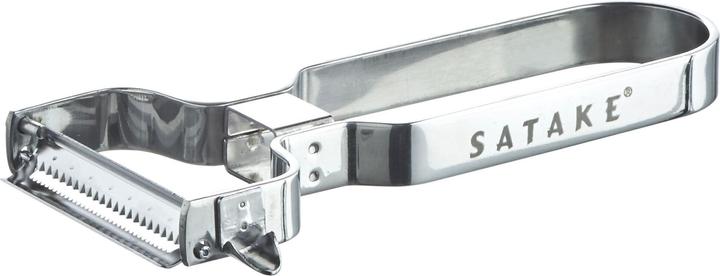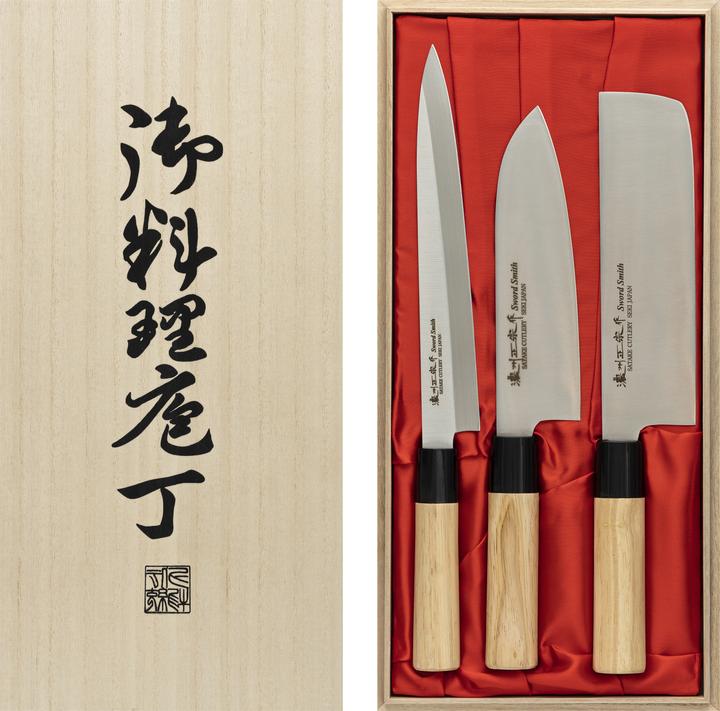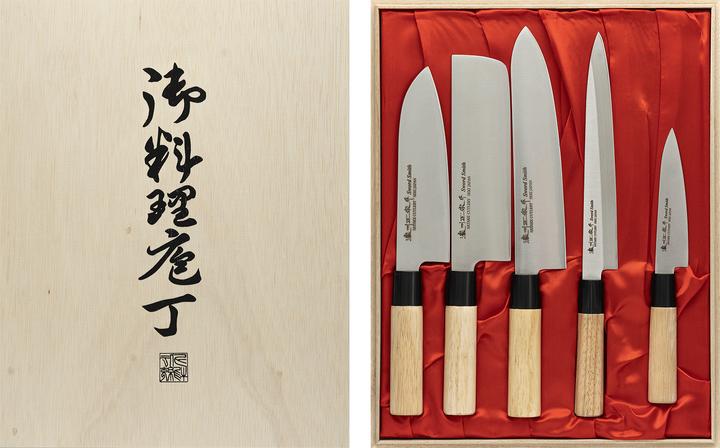
Best Satake products in the Kitchen knives category
On this page you'll find a ranking of the best Satake products in this category. To give you a quick overview, we've already ranked the most important information about the products for you.
1. Satake Noushu Masamuke Saku Chrome Santoku -kokkiveitsi
The chef's knife is suitable for cutting vegetables, meat, and fish, making it one of the most used knives in the kitchen. The very sharp blade measures 17 cm, and its sharpening angle is 15 degrees. The blade is made of high-quality stainless steel with a high carbon content and contains molybdenum. This provides excellent corrosion resistance, ensuring that the knife is long-lasting and highly durable. The handle of the knife is oval-shaped and made of rubber wood.
Japanese Satake Cutlery has been manufacturing knives since 1940 and is one of Japan's most renowned knife brands.
Japanese kitchen knives are made of very hard and thin metal. Therefore, they should not be struck or twisted against any hard materials, such as frozen or bony meat, coconuts, jar lids, etc. There is a risk of pieces breaking off the steel. High-quality kitchen knives should never be washed in a dishwasher; instead, they should be rinsed quickly with water and dried immediately after use. Storage should involve any solution that keeps the knife blades from coming into contact with other metal objects.

2. Satake Peeler, silver
The Satake Peeler in silver is a versatile kitchen tool that is ideal for grating and peeling a variety of ingredients. With its sharp blade, it allows for fine grating of ginger, cucumbers, carrots, lemon zest, and chocolate. The precise craftsmanship ensures that the grater produces strips about 2 mm wide, making it perfect for enhancing sandwiches, sauces, and marinades. Additionally, the peeler can be used to season salads or artistically decorate pastries, making it an essential tool in any kitchen. Weighing 0.3 kilograms, it fits comfortably in the hand and allows for easy handling. The silver color gives the peeler a modern and appealing design that harmoniously blends into any kitchen decor. Whether for professional use or home cooking, this peeler offers functionality and style in one.

3. Satake Kuro Chopper lihakirves
The Satake Kuro Chopper is a coarsely forged knife with a blade made of 5CR15MOV steel, also known as 1.4116 steel. It has undergone eight treatments, ensuring exceptional sharpness and a hardness of 54-56 HRC. The knife features a long handle made from burnt wood, with the ends crafted from 18/8 stainless steel, providing a perfect grip, balance, and stability.
The sharp edge ensures more flavorful and healthier food. The finer cutting surface helps prevent ingredients from losing their color, taste, juiciness, and elasticity during cooking. Additionally, the sharp edge allows cut ingredients to last longer, preventing the flavors of other items in the refrigerator from seeping into them. Each knife is unique, with both the beautiful blades and handles varying in pattern and darkness.

4. Satake Kuro -santokuveitsi

5. Satake Noushu Masamuke Saku Chrome Deba -kokkiveitsi
The chef's knife is the most used knife in the kitchen, suitable for cutting vegetables, meat, and fish alike. The blade's length is 16 cm, and its sharpening angle is 15 degrees. The blade is made of high-quality stainless steel, which has a high carbon content and includes molybdenum. This provides excellent corrosion resistance, making the knife durable and long-lasting. The handle of the knife is oval-shaped and made of rubber wood.
Japanese Satake Cutlery has been manufacturing knives since 1940 and is one of Japan's most well-known knife brands.
Japanese kitchen knives are made of very hard and thin metal. Therefore, they should not be hammered or twisted against hard materials, such as frozen or bony meat, coconuts, can lids, etc. There is a risk of actual pieces chipping off the steel. High-quality kitchen knives should never be washed in the dishwasher; instead, they should be rinsed quickly and dried immediately after use. Any storage solutions where the knife blades do not come into contact with other metal objects are suitable for storage.

6. Satake Noushu Masamuke Saku Light Sashimi -fileerausveitsi
The extremely sharp blade of the filleting knife is the perfect tool for cutting fish. The blade length is 20.5 cm, and its sharpening angle is 15 degrees. The blade is made of high-quality stainless steel with a high carbon content and contains molybdenum. This provides excellent corrosion resistance, making the knife long-lasting and highly durable. The handle of the knife is oval-shaped and made of birch.
Japanese Satake Cutlery has been manufacturing knives since 1940 and is one of Japan's most famous knife brands.
Japanese kitchen knives are made of very hard and thin metal. Therefore, they should not be struck or twisted against hard materials such as icy or bony meat, coconuts, can lids, etc. There is a risk of chipping the steel. High-quality kitchen knives should also never be washed in a dishwasher; instead, they should ideally be rinsed quickly with water and dried immediately after use. All storage solutions that keep the knife blades from coming into contact with other metal objects are suitable for storage.

7. Satake Noushu Masamuke Saku Chrome Sashimi -fileerausveitsi
The extremely sharp blade of the filleting knife is the perfect tool for cutting fish. The blade length is 20.5 cm, and its sharpening angle is 15 degrees. The blade is made of high-quality stainless steel with a high carbon content and contains molybdenum, providing excellent corrosion resistance, making the knife long-lasting and highly durable. The handle of the knife is oval-shaped and made from rubber wood.
Japanese Satake Cutlery has been manufacturing knives since 1940 and is one of the most famous knife brands in Japan.
Japanese kitchen knives are made of very hard and thin metal. Therefore, they should not be used to chop or twist on hard substances like frozen or bony meat, coconut shells, or can lids. There is a risk of concrete chips breaking off from the steel. High-quality kitchen knives should also never be washed in a dishwasher, but preferably should be quickly washed with water and dried immediately after use. All storage solutions where the knife blades do not come into contact with other metal objects are suitable for storage.

8. Satake -veitsisetti, 3 cpl

9. Satake -veitsisetti, 5 cpl

10. Satake Masamune Saku Bread Knife, 20 cm
Japanese Satake Cutlery has been making knives since 1940 and is one of Japan's most well-known knife brands. The serrated bread knife is designed for cutting all kinds of bread. The thin and sharp edge cuts through even hard and crusty crusts excellently, allowing the slicing of thin pieces while maintaining the shape of the bread. The blade length is 20 cm and the width is 2.7 cm, made from high-quality stainless steel. The knife handle is made of durable polypropylene.
Japanese kitchen knives are made of very hard and thin metal. Therefore, they should not be chopped or twisted against hard substances like frozen or bony meat, coconut shells, or can lids. There is a risk of pieces coming off the blade. Quality kitchen knives should also never be washed in the dishwasher; instead, they should be quickly rinsed and dried immediately after use. All storage solutions where the knife blades do not come into contact with other metal items are suitable for storage.
